|
|
|
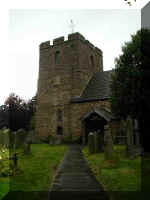 |
|
External view of the church, from
the church path which leads south-east. The Castle (2,
3) is at about 90 degrees to the left of where the
picture was taken. |
|
|
2
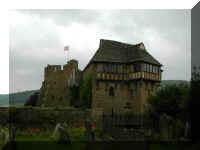
|
|
3
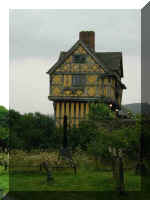
|
4
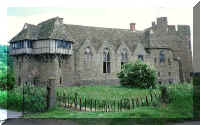 5
5

|
|
|
|
6
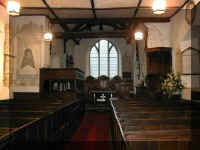
|
|
6 The nave looking into
the chancel (really only a continuation of the nave),
with the canopied pew on the left (north) and the
two-decker pulpit on the right (south). |
|
|
7
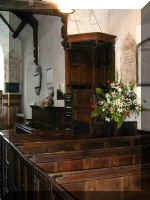
|
|
|
|
8
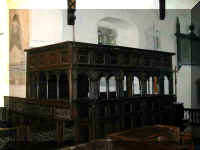
|
|
|
|
9
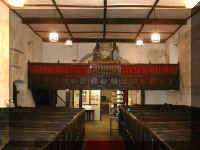 10
10
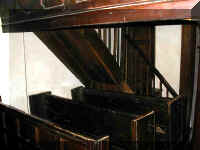
|
|
9 & 10 The West
Gallery, and the staircase leading to it. Under
the stairs are the five pews which survived the Civil
War. At the north side of the gallery there is a
space for musicians The band comprised a bass viol,
flute and clarinet, and was replaced about 1855 by a
harmonium, and later still by the present organ.
|
|
|
11
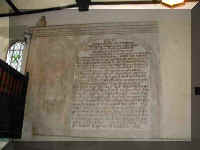
|
|
11 The Ten Commandments
written in a panel on the wall, very visible from the
west gallery. |
|
|
The
Church at Stokesay.
The church was built about 1150 as a chapel to the
castle by the Say family who had come over with William the
Conqueror. The Says came here about 1105 via Clun. The
'Stoke' part of the place-name means a 'dependent settlement' or a
'dairy farm' and implies a fenced off area.
In 1646 a Royalist party with their horses took
refuge in the church, but they were driven out by Parliamentarians
who had captured the castle. Much of the church was destroyed in
the battle: the south side of the nave, facing the castle, was
destroyed entirely, probably by canon shot. The north side
was not damaged so severely: here the jambs run half-way up the
single-light windows, showing that up to this height the wall
probably survived the Civil War bombardment.
The oak door, with its massive lock and key, date
from 1654.
The Nave of the church is a rare act of church
building in Puritan times. Its date (1654) can just be seen on the
tablet at the head of the tower arch.
The walls of the church display several attempts
at decoration in a devotional manner. The Ten Commandments are
painted on the north wall with figures representing Moses and
Aaron on either side. The central square would originally
have been for the Royal Arms. All the texts and the Lord's
Prayer were brought to light about 1870 when the walls were
scraped prior to re-colour washing. In 1988-89 expert help was
obtained to conserve them.
The chancel was restored in 1664, as may be seen
by the date on the eastern side of the supporting beam. The arms
of the Baldwyn family , who occupied the castle at the time, can
be seen on the corbels. At one time a panelled oak screen was
attached to this beam, but was taken down to make room for the
choir stalls about 1900.
|
|
|
Short
history of the Fortified Manor House, now known as Stokesay Castle
Stokesay is first heard of in the period
immediately after the Norman Conquest. Roger Montgomery was
created Earl of Shrewsbury by William the Conqueror, the land
being granted to him including the Manor of Stokesay. Roger
Montgomery, in turn, granted this Manor to one of his retainers,
Roger de Lacy.
The Say family were the tenants of the Manor until
the death of Walter de Lacy in 1240, when his son-in-law John de
Verdon inherited the title and obtained possession of the Manor
from Hugh de Say by exchanging land with him in Ireland.
The north tower and parts of the solar block may
be the work of John de Verdon as the building of the present Manor
house dates from about this time.
Verdon's tenant, John de Grey, sold the tenancy of
Stokesay to the merchant Lawrence of Ludlow in 1281. We can assume
Lawrence continued with the building soon after 1281, while
completion, or approaching completion, of his work is perhaps
indicated by the 'licence to crenellate' which he obtained in 1291
from Edward I at Hereford.
For
further details and larger pictures link here to http://www.castlewales.com/stokesay.html
|
|
The
Gallery
The gallery at the west end is thought to be 17th
century, and was until about 1855 the place used by musicians and
'songsters' (to quote the Church Guide).
After that an organ was installed and occupied a space on the
north side of the church, between the canopied pews and the
sanctuary. The present organ . . . brought music back to the
gallery when it was installed there in 1967.
Under the gallery are five primitive pews which
escaped destruction in the Civil War. The ledges are for feet, not
books!
Other
church furniture.
The box or canopied pews in the chancel are
finely carved, but not exactly designed for worship. The principle
families in the parish would have used them, after entering the
church through what is now a blocked up doorway in the wall
opposite. These pews, like the pulpit, date from
1664-65. The pulpit was originally a three-decker,
but was modified in 1900. In 1987, however, the Reading Pew
was restored to a two-decker with fixed seal and steps with side
panel.
|
|
Dove's reference to the bells |
|
Stokesay, Salop,
S John Bapt (GF), 6, 9cwt in A flat.
|
|
ACCESS |
|
Map reference : SO
436 817
The church was open at the time of
our visit. [July 2002]
|
|
|
Photographs: ©
Edwin Macadam 2002
|
Please see our
Home Page
for important copyright notice |
|

|
|

|
|
|

|
|
|
|
|
SEARCH THIS SITE |
|
|
This
site has been constructed by, and remains the copyright of,
its authors,
Edwin and Sheila Macadam,
Shelwin, 30, Eynsham Road, Botley,
Oxford OX2 9BP
|
|
| ©
July 2001 -
|
|
 5
5


